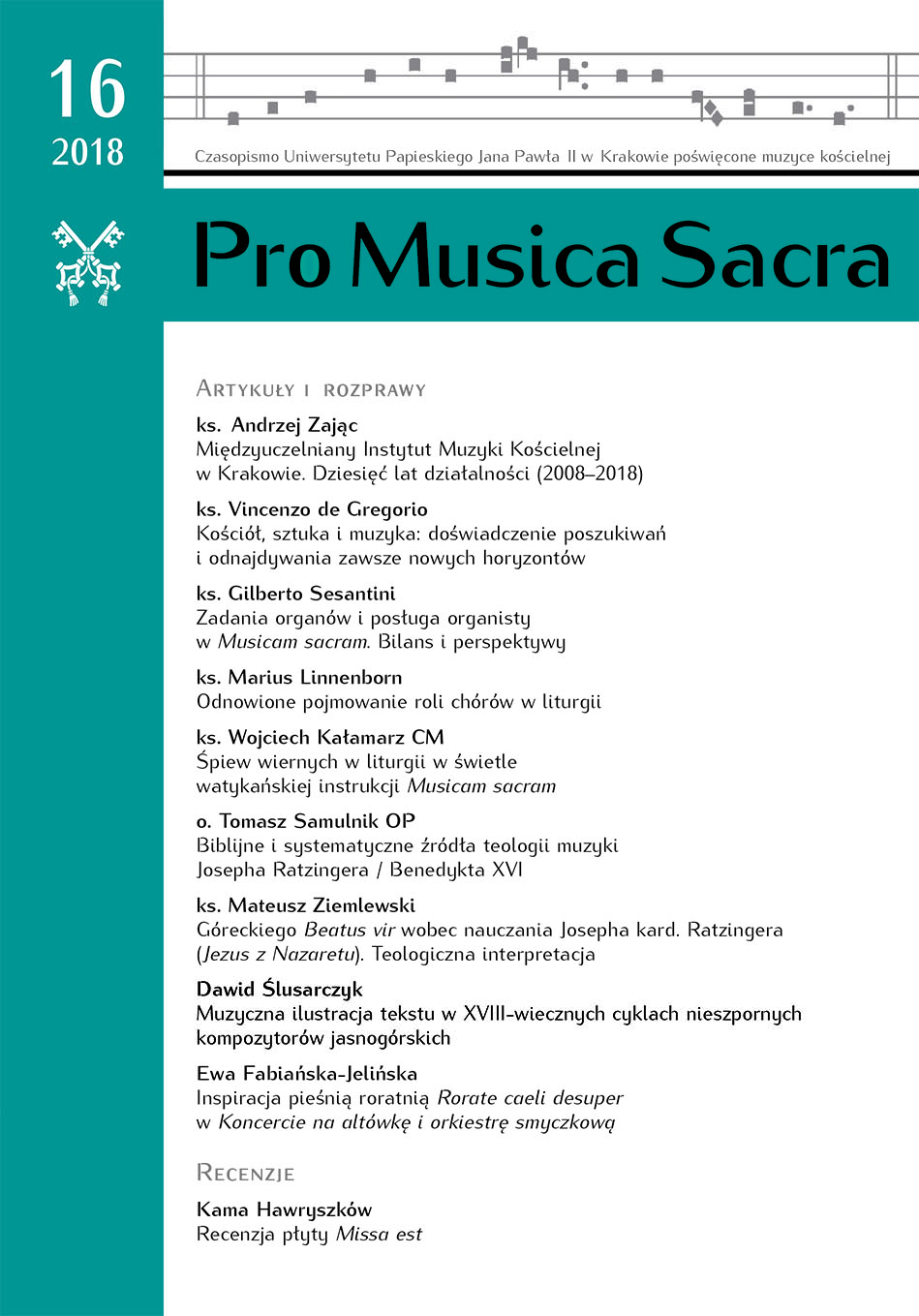Inspiration of early morning advent mass song Rorate caeli desuper in the Concerto for viola and string orchestra
DOI:
https://doi.org/10.15633/pms.2583Keywords:
composer, inspiration, rorate song, luminosity, darkness, Advent, viola, concerto, string orchestra, initial motifAbstract
The author describes the inspiration for and background to the creation of the Concerto for viola and string orchestra. It elaborates the sphere of the composer’s inspiration: the religious period of Advent (rorate mass and its song Rorate caeli desuper) with the accompanying reflection on the symbolism of luminosity and darkness. The basic idea of sound in the concerto for viola and string orchestra was inspired by a musical quotation from the initial motif of the rorate song Rorate caeli desuper. The opening tunes of the song became the foundation for the development and shaping of the sound material in the subsequent movements of the viola concerto. The musical architecture and dramatic content of the entire piece rests on the aforementioned quote, which integrates the particular movements in accordance with the concept of unity in diversity understood as coherent input sound material whose narration is enriched by being presented in various sound contexts.
References
św. Augustyn, Wyznania, Kraków 2000.
Barrett H., The viola, Alabama 1996.
Cegiełła J., Szkice do autoportretu polskiej muzyki współczesnej, Kraków 1976.
Fąferek M., Wszystko, co chcecie wiedzieć o altówce, a boicie się zapytać, „Polska Muza” 17 września 2013, http://www.polskamuza.eu/wywiady.php?id=867.
Franciszek, Encyklika Lumen fidei do biskupów, prezbiterów, do osób konsekrowanych i do wszystkich wiernych świeckich o wierze, Kraków 2013.
Jan Paweł II, Przemówienie do Zgromadzenia Ogólnego ONZ, w: Jan Paweł II, Przemówienia i homilie Ojca Świętego Jana Pawła II, red. J. Poniewierski, indeks P. Murzański, Kraków 1997.
Ingarden R., Studia z estetyki, Warszawa 1966.
The Liber Usualis, ed. Benedictines of Solesmes, Tournai–Nowy Jork 1961.
Makota J., Twórczość artystyczna: proces twórczy, „Studia Estetyczne” 18 (1981), s. 95–116.
Menuhin Y., Primrose W., Violin and viola, London 1990.
Michałek K., Miłosierdzie Boże jako źródło inspiracji twórczej, „Pro Musica Sacra” 11 (2013).
Pismo Święte Starego i Nowego Testamentu. Biblia Tysiąclecia, Poznań 2003.
Poniatowski S., Altówka. Sztuka i dziedzictwo, tłum. B. Maliszewski, Gdańsk 2014.
Riley M., The history of the viola, vol. 1, vol. 2, Ann Arbor, 1991.
Stróżewski W., Dialektyka twórczości, Kraków 1983.
Stróżewski W., Wokół piękna. Szkice z estetyki, Kraków 2002.
Downloads
Published
Issue
Section
License
Copyright (c) 2018 Ewa Fabiańska-Jelińska

This work is licensed under a Creative Commons Attribution 4.0 International License.
The author declares that he/she owns the copyrights to the work and that they are not limited in the scope covered by this declaration, and that the work is an original work and does not violate the copyrights of others.
The author permits the Pontifical University of John Paul II in Cracow to use the work free of charge, non-exclusively and indefinitely, that is:
- to record and reproduce: produce copies of the work by printing, reprography, magnetic recording and recording with the digital technique;
- to circulate the original or copies on which the work has been recorded (to introduce into circulation, lend or hire of the original or copies, public exhibition, display as well as make the work available to the public in such a manner that everyone can have access to it in a place and at a time of their choice);
- to include the paper in a collective work;
- to grant the Creative Commons Uznanie autorstwa-Użycie niekomercyjne-Bez utworów zależnych 3.0 Poland sublicense by Pontifical University of John Paul II in Cracow
The Pontifical University of John Paul II in Cracow makes the work available on the University's Periodicals Platform owned by the University under the Creative Commons Uznanie autorstwa-Użycie niekomercyjne-Bez utworów zależnych 3.0 Polska licence. This entitles all interested parties to use the work under the following conditions:
- the author and title of the work will be presented,
- the place of publication (the title of the magazine and the URL of the original work published)will be indicated,
- the work will be distributed in a non-commercial manner,
- no derivative works will be created.

